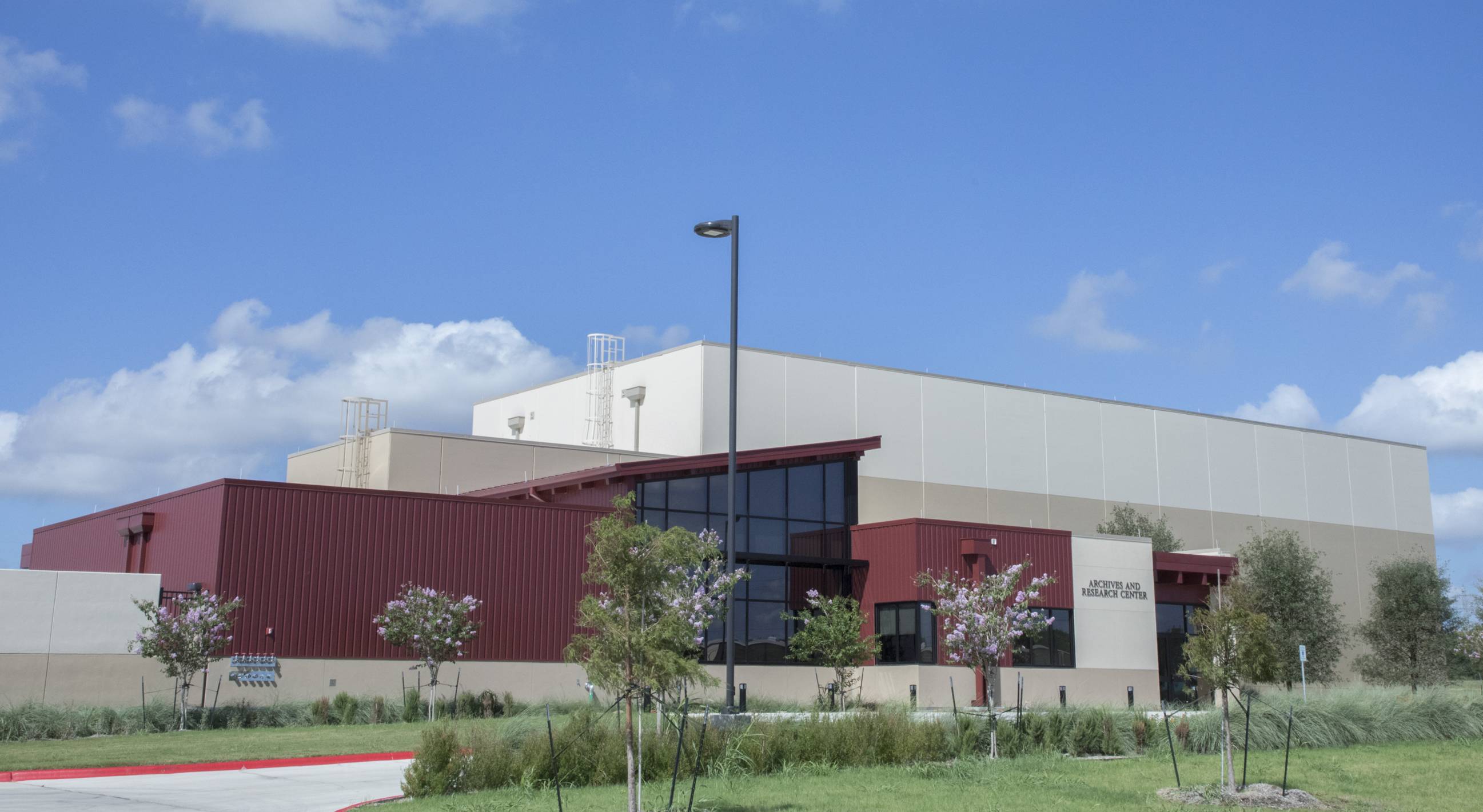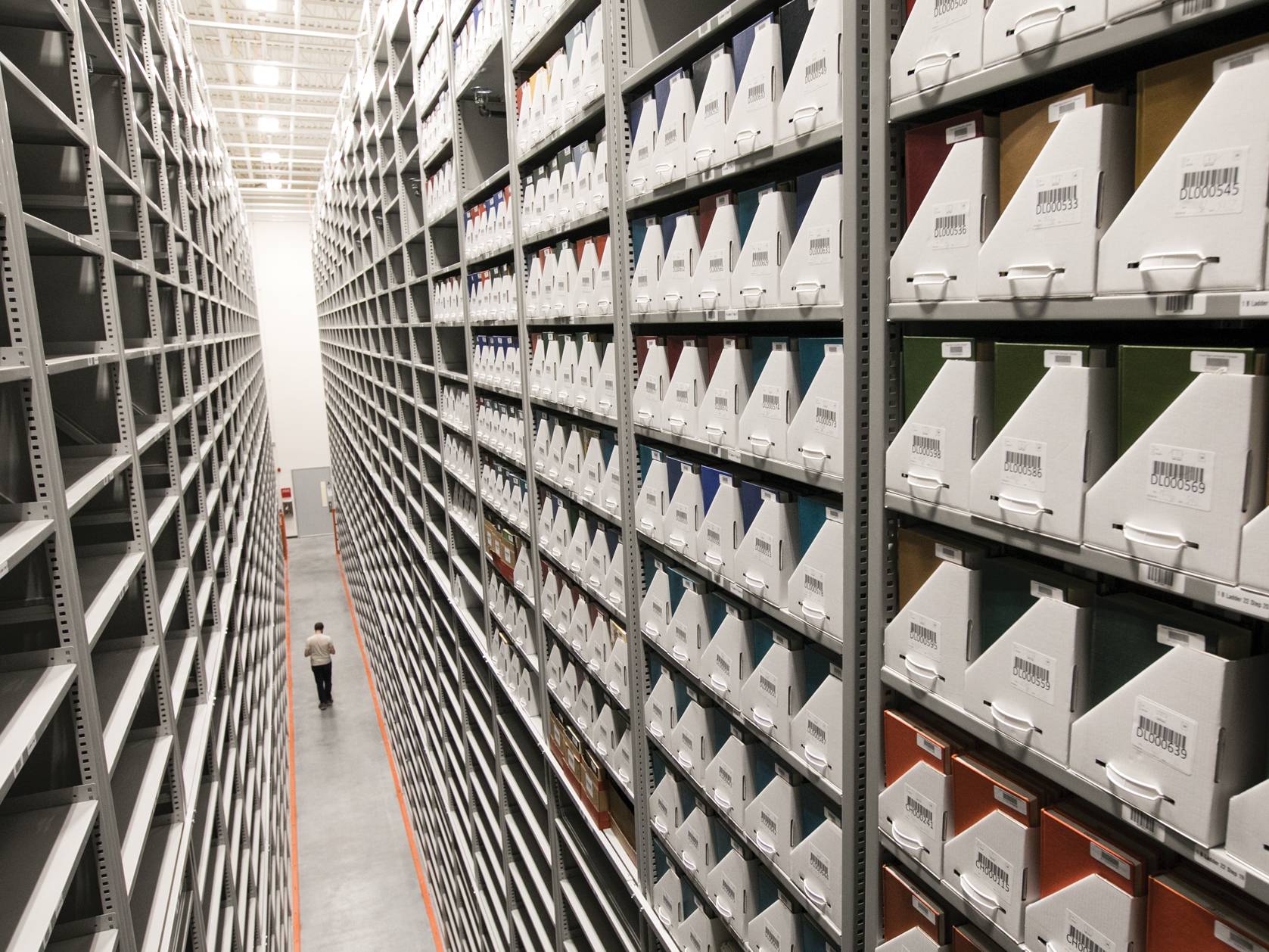
From Alkek to the ARC
by Dan. R. Goddard
New facility welcomes researchers to delve into more than 600,000 items
Hundreds of thousands of books, photographs, paintings, and other items tucked away deep in the stacks of Texas State University’s Albert B. Alkek Library and in off-site storage facilities are finding a new home on the 6 miles of multi-stacked, high-density shelving in the $15.4 million Archives and Research Center (ARC), which opened this past fall at the university’s Science, Technology, and Advanced Research (STAR) Park in San Marcos.
Designed by Harrison Kornberg Architects of Houston to protect many of the university’s valuable collections in a climate-controlled environment, including a special Arts and Artifacts space for paintings and other objects from The Wittliff Collections and the University Archives, the 14,000-square-foot ARC mingles big-box retail warehouse know-how with state-of-the-art preservation technology. But unlike similar archives at some other major research universities, the ARC was designed with visitors in mind.
"We designed our building to be patron-friendly and welcoming to faculty, staff, and researchers," says Joan Heath, associate vice president and university librarian. "Some other high-density facilities are not accessible to the public, but as part of the university’s research campus, it was important for us to offer a reading room and instruction space that would support on-site research." Texas State students, faculty, and visiting scholars, upon request, will utilize the ARC’s Reading Room featuring the latest equipment available for viewing, digitizing, and printing research materials, though patrons are restricted to using the traditional lead pencil and paper for taking notes.
Currently, the library staff is in the process of moving more than 600,000 library items and 3,000 linear feet of archival materials to the ARC. The move isn’t expected to be completed until 2019. Anything in the general collections that hadn’t been checked out in 10 years became a candidate for the ARC, which can hold more than a million items.
"After close consultation with faculty, our subject librarians determined which items needed to be removed from the collection and then determined which of the remaining items should stay in the Alkek Library," Heath says. "The rest were slated to be sent to the ARC for preservation as they were less likely to be checked out."

rise nearly three stories above the floor.
However, items stored in the ARC can be requested online and delivered daily to the Alkek Library. Materials also are being shared with the Round Rock Campus Library.
Large windows permit natural light in the front offices of the ARC, which is primarily devoted to two windowless warehouse-size storage areas.
Equipped with rolling dividers designed to hold framed paintings and photographs usually found in art museums, the Arts and Artifacts room has a 20-foot-high ceiling and is maintained at a constant 68 degrees with 40 percent humidity. The main high-pile unit, where books and manuscripts go, has a 40-foot ceiling and is environmentally controlled at 50 degrees with 30 percent humidity.
Kenneth Pierce, vice president for information technology, says the climate-controlled system in the ARC can extend the life of the materials stored within the building for hundreds of years. "We also have a high-tech fire prevention and suppression system that includes an extremely sensitive Very Early Smoke Detection Apparatus that will detect particulates in the air, and a main fire suppression system that is dry with a secondary water suppression system that will activate only when smoke is actually detected," Pierce says.
But the books aren’t lined up neatly by subject and in alphabetical order by author. ARC manager Mike Ellis, who has a background in big-box retail warehousing, explained books and other materials are sorted by size, and bar codes are used in conjunction with the online catalog to indicate where the books are stored in trays that fit easily on the shelves. Workers stand on specially designed risers that can hold a library cart to access the highest shelves up to nearly three stories above the floor. "High-density means we’re trying to fit the most materials we can into the smallest possible space," Ellis says.
Pierce says the university is making good use of the space being freed up by the ARC. "Having this new library facility gives us the opportunity to make room in the Alkek Library for newer library materials and to make significant upgrades to the library that will include adding new research technology and collaborative work centers for the students and faculty at Texas State," he says. "It also allows us to expand The Wittliff Collections space on the seventh floor to accommodate the increasing demand for exhibit space as our collections grow."
Planned upgrades at the Alkek Library include virtual reality and interactive learning environments, a makerspace center, 3-D technologies, video presentation studios and practice labs, model classrooms, and an expansion of the Geographic Information System data and research hub. Along with the latest in software and computer technologies and more group study and work areas, the Alkek will add a café and a commons area for graduate students.